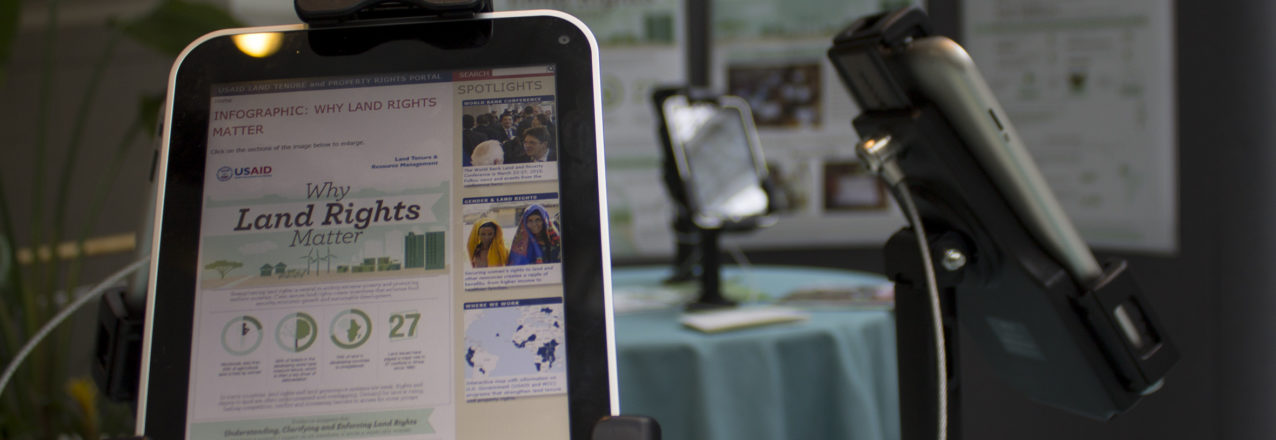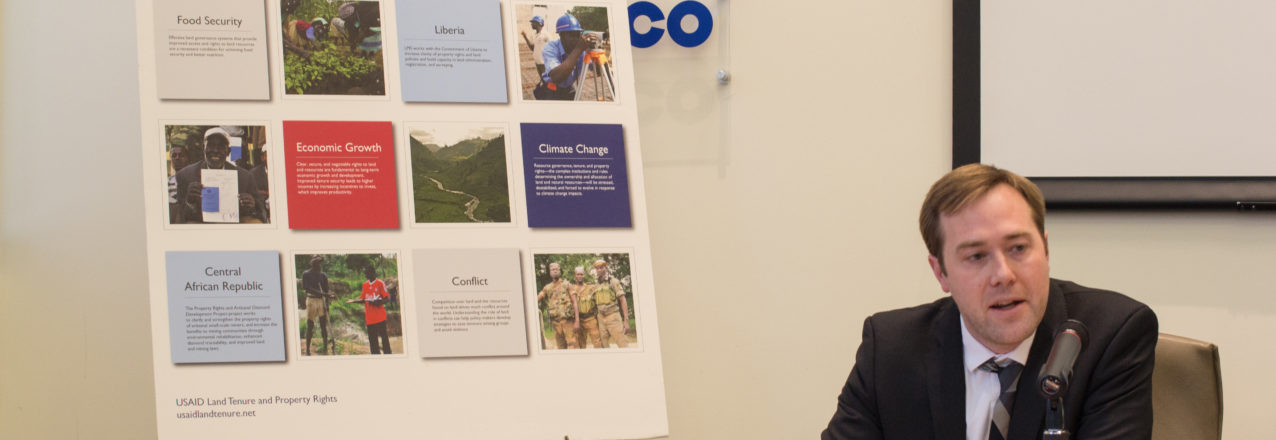
Each quarter we will interview an expert whose work touches on aspects of land tenure and resource management. These will include evaluation specialists, country experts or USAID staff.
Our first interview is with Dr. Lauren Persha, Assistant Professor in Department of Geography at the University of North Carolina at Chapel Hill. Dr. Persha is a member of the core research team of the Impact Evaluation of USAID’s Tenure and Global Climate Change (TGCC) project in Zambia. The Impact Evaluation team’s work was presented at this year’s World Bank Conference on Land and Poverty.
We asked Dr. Persha, an interdisciplinary social-ecological systems researcher, five questions to get a deeper understanding of natural resource governance and trends in the forest sector, based on her experience and research.
1) Can you tell us a little bit about your background?
I started out working in East Africa with an Integrated Conservation and Development Project that was piloting forest sector decentralization in villages and forest reserves across three countries. Through that work I became really interested in the complex social and institutional aspects of getting natural resource, land, and governance interventions to work, incentivizing behavior change, and ways to effectively communicate information and support development in rural villages. After that project I returned to the U.S. to get more training via an interdisciplinary PhD program and post-doctoral fellowship. For the past twelve years, I’ve been involved in research to understand linked livelihoods, land use and conservation outcomes in different land and natural resource governance systems. Together, these experiences moved me towards an interest in using stronger tools and research approaches to better understand how these systems work and identify mechanisms for positive change.
2) You have done work on the commons* with some of the leading scholars in this field. Why is it important to a) study and b) protect the commons?
It’s important to study the commons and common-pool resource management because they are so ubiquitous, and highly depended on by many people across the world. This is especially so where traditional systems to manage common pool resources or commons lands are still practiced or being revitalized through newer land tenure or decentralized initiatives. Also, many natural resources or land use systems function as common-pool resources even if they are not explicitly governed as such.
But despite their ubiquity, commons and common-pool resources can be difficult to sustain because of their inherent basic characteristics: they are subtractable resources, but their physical or landscape characteristics often make it difficult to effectively exclude people from accessing them. So, commons are challenging places to manage, regulate and govern. But, there are many groups around the world—many of them in traditional resource or knowledge systems—that have developed effective systems for the collective use and management of commons. Studying the commons (successful ones and those performing less well) helps to increase knowledge on how to strengthen sustainable use and governance of commons systems—for example what kinds of rules and institutional arrangements within communities help facilitate effective management, or maintain equitable benefits across different groups.
It’s important to protect the commons because so many people around the world, particularly in many of the poorest countries, depend on commons resources for their daily lives. And they do so in ways that often are unlikely to be amenable to some of the alternatives to customary commons systems that governments have imposed, such as land privatization or management via centralized state regulation.
3) As you know, some people worry that if management and control over natural resources are devolved to local groups the resources will not be well managed. What have you found in your research?
This is a commonly raised concern, but research across the extensive body of work around natural resource devolution, including my own, has shown that “devolution = resource decline” is not a foregone conclusion. Instead, much work shows that there are many cases where devolution works very well, as well as cases where it fails. Similarly, there are successes and failures across all of the management alternatives to devolution, such as privatization, centralized management or increasingly strict resource protection and community exclusion. So, the challenge is to understand the factors that facilitate devolution to work—together with the policy design and implementation processes that are effective under different conditions—and then to target devolution appropriately to contexts where there is a likelihood of a good fit.
Research suggests there is no single factor on which “success” rests. However, much work points to several key factors. For example, research increasingly shows that when local people who depend strongly on a resource for their livelihoods are allowed to substantively participate in managing and making decisions about the resource (often envisioned through devolution but not always implemented in practice), the likelihood of more sustainable use is often significantly higher. So, learning how to better engender truly substantive participation across groups who heavily depend on natural resources is important.
Ultimately, understanding how the particular constellation of institutional arrangements for management is structured and operates in practice, and how this shapes the incentives for people to make sustainable and equitable decisions around resource use, is key.
4) Can you talk a bit about what contributes to, or makes for, good governance in the forest sector?
Governance issues lie at the core of forest sector research and policy action, particularly in the context of now widely implemented decentralized strategies, which essentially aim to use governance changes to improve forest conservation and livelihoods. Good governance is crucial for sustainable resource use, forest-based livelihoods and economic growth. This is a multi-faceted concept that includes transparent use of public resources, effective service delivery to constituents, a decision-making process that is viewed as legitimate and inclusive (especially of traditionally disempowered or marginalized groups), and creating opportunities for substantive participation of diverse stakeholders. Some of the more widely emphasized elements that are thought to contribute to achieving good governance include: strengthening substantive participation in forest decision-making by those who directly depend on forests; building upward and downward accountability into decision-making; and finding ways to generate functional and equitable sharing of revenues or other tangible benefits from forests.
5) Finally, are you encouraged or discouraged by trends relating to forest and resource governance and why?
I am really encouraged by the current visibility and action around forest and resource governance issues today, which is important in its own right, but also hugely relevant for land issues in general, livelihoods and equity interests, and support for long-existing customary land use and management systems. The last few decades have seen an overwhelming number of governments around the world passing policies and laws in support of more devolved or inclusive forest and resource governance; and together with that, substantial changes in land laws—for example, formally recognizing and embedding customary rights to forest lands and resources or communal land titling within the legal system. So there is an important nexus taking place right now across land issues generally, and forest and natural resource governance specifically. We also see global support for improving forest and resource governance across a wide range of sectors, public and private organizations and NGOs, and more integrative dialogue across these different interests. We have a new generation of forest and resource management programs and stronger technologies and tools to gather and share information. All of this has, I think, opened up some very good opportunities for improvements at scale—if effective learning can take place—and is reason to be optimistic.
*Commons: natural and cultural resources or assets that all members of a group or community are able to access and have rights over. Such resources are typically owned jointly, not as individual property.








